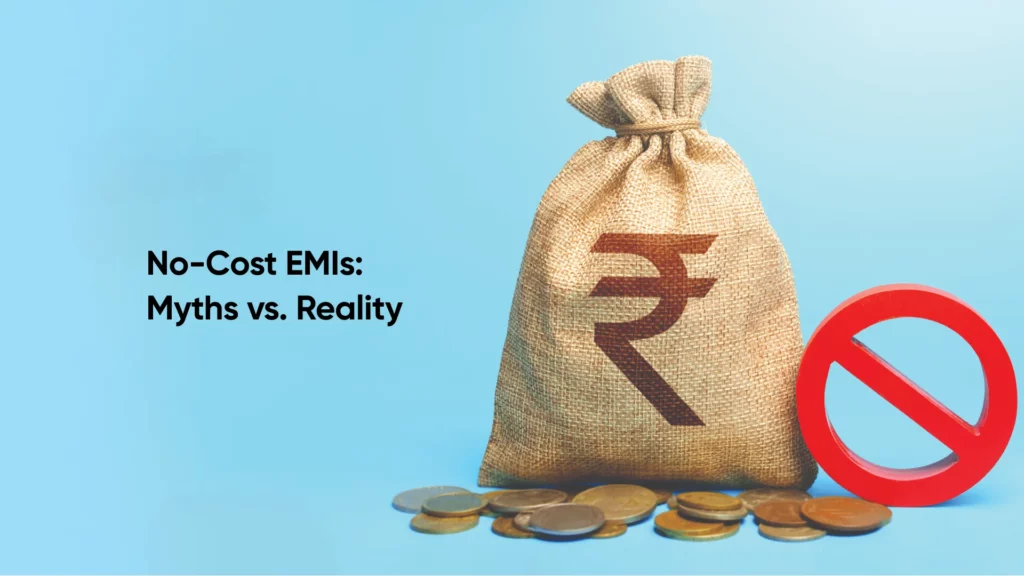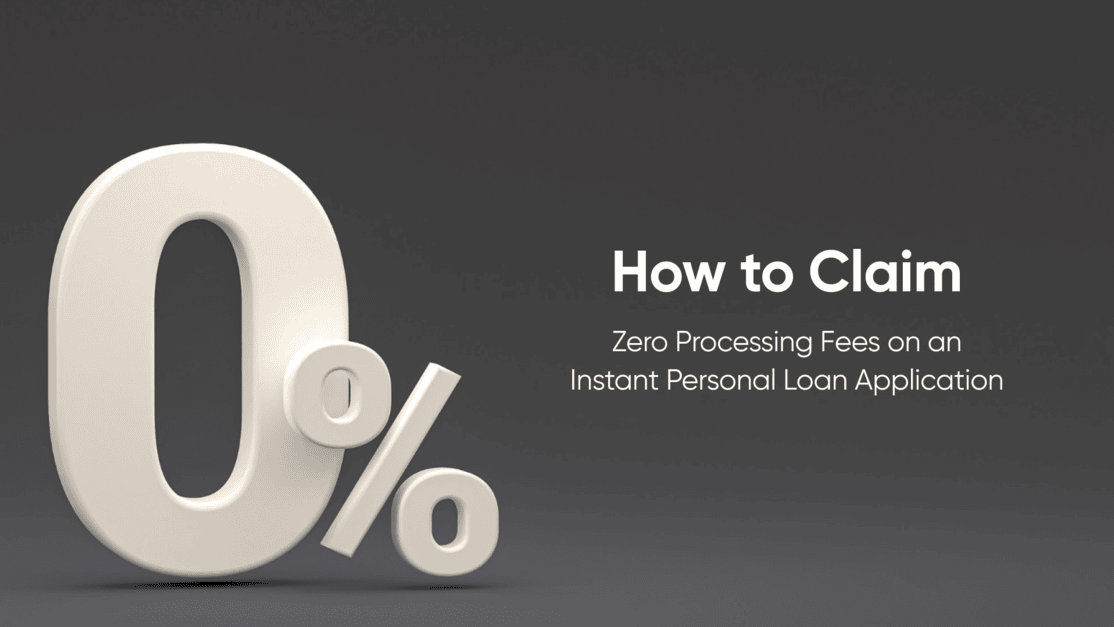No-Cost EMIs: Myths vs. Reality

Table of Contents
ToggleWhat is No-Cost EMI?
Let’s understand in detail What does no-cost EMI (Equated Monthly Installment) means. No-cost EMI is an option that gives customers the freedom to buy goods and services without paying additional processing or interest costs. It enables customers to pay for their purchases in reasonable monthly installments over a certain period without incurring any additional costs.
People find this payment option especially appealing because it makes goods and services that they might not otherwise be able to buy within their immediate budget. Customers can take advantage of the ease of making purchases without having to worry about paying high-interest rates by spreading out payments without incurring additional expenditures. All in all, no-cost EMI offers customers a practical and affordable alternative to gradually purchasing desired goods.
Benefits of No-Cost EMIs
Buyers can select installment plans that suit their financial capacity because of the flexible repayment alternatives offered by no-cost EMI personal loans. Choose an optional tenure that is suitable for you by reviewing different lenders. Without feeling compelled to make large payments all at once, this flexibility enables people to manage money more efficiently. Let’s get into the major benefits of no-cost EMI.
Allows Budget-Friendly Purchases:
No-cost EMI personal loan lets customers buy their favorite products without breaking the bank. People are better able to manage their finances when the payment of goods and services is spread out over several months. With this method, one can purchase valuable goods without having to pay the full cost upfront, which makes pricey purchases more affordable and available to a larger group of customers.
Eliminates Interest Charges:
The elimination of interest fees is one of the primary benefits of choosing an interest-free EMI. In the long run, buying products or services becomes more affordable due to the lack of interest charges. This also reduces the overall financial strain on consumers.
Flexible Repayment:
No-cost EMI personal loan gives consumers flexibility in terms of repayment choices, enabling them to select installment plans that suit their budgets. Customers can choose the payback time that best fits their demands and financial limits from a variety of tenure options. People are empowered to handle their money more skillfully because of this flexibility, as they are not under any obligation to make large payments all at once.
Also Read: Flexi Personal Loan – Check Eligibility, EMI, Advantages
Better Budget Management:
No-cost EMI provides customers with an easier way to manage their spending when they make purchases. Spreading the expense of expensive things over a certain planned duration instead of paying the entire amount at once is a big benefit. By dividing the entire expense into smaller, easier-to-manage payments, customers may better balance their spending against their income and other financial commitments. Because customers can arrange their budgets around the EMI scheme’s fixed monthly payments, it also reduces the chance of overspending or debt accumulation.
How Does it Work?
Buyers can spread the cost of their purchase over a specified period without incurring any additional interest charges in no-cost EMI. Buyers have the option of making equal monthly payments over the agreed-upon term rather than paying the entire cost at once or choosing typical installment plans that include interest fees. The benefit of the no-cost EMI is that the customers can pay the full cost of the good or service, split into affordable installments.
This not only increases transparency regarding total costs but also considerably reduces the financial strain on borrowers. This is beneficial to both parties by providing no-cost EMIs. The idea behind no-cost EMIs is a consumer-focused payment solution that places an emphasis on easy accessibility and transparency.
How Is a No-Cost EMI Calculated?
Important terms to understand to calculate no-cost EMI:
Total Loan Amount: The total purchase value is divided by the customer’s selected number of installments in no-cost EMI. This guarantees that the consumer will just pay back the principal amount and won’t incur any further interest.
Interest Component: Unlike traditional EMIs where interest is charged on the loan amount, in a no-cost EMI, the interest component is covered by the seller or financial institution offering the scheme. This makes the EMI effectively interest-free for the customer.
Processing Fees: Even if there are no interest fees, the loan may still have processing costs. For more transparency in the transaction, these fees are usually paid upfront or added to the loan amount.
Loan Tenure: The loan tenure is the duration during which the loan is repaid. This affects the amount of the monthly installment. Opting for a longer tenure generally results in lower EMIs, while shorter tenures lead to higher monthly payments.
Frequency of Payments: EMI payments may be made on a monthly, quarterly, or even bi-annual basis, depending upon the terms. The frequency of payments affects the overall personal loan repayment schedule and budgeting for the customer.
Additional Charges: Clients should be informed of any additional fees, such as prepayment or late fees, that might be incurred in accordance with the terms of the loan arrangement. Understanding these charges helps in managing the debt effectively.
Discounts and Offers: The effective cost of the loan may be further decreased by discounts or offers by sellers or financial institutions. These incentives are an add to the no-cost EMI plan which strengthens the value for the customer to opt for the scheme.
Example:
Suppose you are taking an EMI on personal loan of Rs 5 lakh
Loan amount: Rs 5,00,000
Loan term: 24 months (about 2 years)
Processing fee: Rs 2,000
To calculate the monthly installment with the processing fee included:
Total loan amount = Loan amount + Processing fee
= Rs 5,00,000 + Rs 2,000
Total loan amount = Rs 5,02,000
Now, we’ll use this total loan amount to calculate the monthly installment:
Monthly installment = Total loan amount / Number of months
Monthly installment = Rs 5,02,000 / 24
Monthly installment ≈ Rs 20,916.67
So, with a processing fee of Rs 2,000 added to the loan amount, the monthly installment would be approximately Rs 20,916.67 for 24 months (about 2 years).
So, in this case, for a “no-cost EMI” on a personal loan of Rs 5 lakh over 24 months, the borrower would pay approximately Rs 20,916.67 each month for 24 months, resulting in a total repayment of Rs 5,00,000 at the end of the loan term.
To learn more about EMIs and to understand how to calculate no-cost EMI, visit our website for a personal loan EMI calculator online to precisely calculate your monthly installments.,
You can easily use a personal loan EMI calculator just by entering your loan amount, preferred loan period, and any other relevant information.
Also Read: Installment Loans: Know what is it And How Do it Work
Common Myths About No-Cost EMIs:
While it’s easy to understand What is no cost EMI, there are several misconceptions about how they work and their actual cost effects. Let’s look into some popular misconceptions about no-cost EMIs and clear out the misinformation:
No Hidden Costs: Contrary to the popular misconception that no-cost EMIs come with no hidden costs, no-cost EMI may involve hidden charges. There may be processing fees or other expenses related to the loan. This must be informed prior by lenders to maintain transparency between both parties. Usually, the terms and conditions of the loan agreement include information about these fees.
No Impact on Credit Score: Credit record will be affected if the EMI payments are delayed or missed. This will affect the borrowers to get future loans. Lenders may hesitate to provide you with the loan if the credit story is not clean.
Instant Approval: Though some might think, a cost EMI truth is that it guarantees instant approval without any checks. However, lenders usually assess the customer’s creditworthiness and may require documentation or credit checks before approval.
No Prepayment Charges: To understand any possible prepayment penalties, it is important for you to review the terms and conditions of the loan agreement. People often assume that there won’t be any charges involved if the part payment is done before the due date. Borrowers should ask for clear clauses involved while opting for such loans.
All Products Are Eligible: Certain products might not be eligible for no-cost EMI plans. This option might not be accessible for some high-value or low-margin products, or it might only be available during a certain promotional period. Clients should make sure they are qualified before assuming that every product qualifies for a no-cost EMI.
What is the Reality of No-Cost EMI?
No-cost EMI is not always no-cost: No-cost EMIs could not really be entirely no-cost. While borrowers might not pay interest directly, lenders often recover the interest by adjusting interest costs on the product’s price or adding processing fees. Customers must carefully read the terms and restrictions to understand any extra expenses related to no-cost EMIs.
Product prices are higher: No cost EMI reality is such that businesses provide EMIs inflating the prices of goods to cover the interest cost. As a result, buyers can end up paying more for the goods than they really should, which would negate the advantage of no-cost EMIs.
Product selections are limited: Usually, no-cost EMIs are offered only on a limited number of products or from certain retailers. Customers thus have fewer options making it difficult to make the right choice desired with a no-cost EMI option.
It might impact your credit score: Selecting several no-cost EMIs at the same time could affect your credit rating. This is a no-cost EMI reality where consumers need to consider how credit scoring can affect their track record to get future loans. Every loan application is noted on your credit report. Applying for credit more than once in a short period of time could indicate to lenders that you are having financial difficulties, which could lower your creditworthiness.
Monthly Installments are high: No-cost EMIs often come with shorter repayment tenures compared to traditional EMIs. While this may seem advantageous in the short term, it results in higher monthly installments, potentially straining the borrower’s finances. Borrowers should evaluate their ability to repay within the shorter tenure before opting for a no-cost EMI. This is no no-cost EMI reality, of which one should be aware.
Multiple EMIs can Impact Future Loans: When reviewing loan applications, lenders consider your current debt obligations, and several ongoing EMIs which may have an impact on your debt-to-income ratio. The no-cost EMI reality is that borrowers must consider before taking on multiple EMIs which might limit their financial freedom and if not paid on time, they will be eventually less eligible for loans or credit in the future.
Missing EMIs can lead to penalties: While there are no interest fees associated with no-cost EMIs during the repayment period, there may be additional fees if an EMI payment is missed. It is important for borrowers to be aware of these possible penalties. Repayment of EMIs on time can help you to get off such penalties and improve your credit score for future loans.
Comparing No-Cost EMIs with Traditional EMIs
Consumers frequently must choose between standard EMIs and no-cost EMI when it comes to financing purchases. We’ll go over the main distinctions between standard and no-cost EMIs in this comparison to assist customers in selecting the best payment option for their circumstances.
| Point of difference | No-Cost EMI | Traditional EMI |
| Meaning | Under No-cost EMI, you are required to pay only a fixed amount from principal amount borrowed every month and need not pay any interest charges. | A regular EMI needs you to pay back a fixed amount of money every month on a specific date, including interest charges |
| Interest Charged | A no-cost EMI plan has no interest cost included, which indicates no additional charges. The only amount you need to pay is the principal amount borrowed. | Need to pay principal amount plus interest levied on that amount. |
| Tenure Flexibility | Tenure may be limited, resulting in higher monthly payments. | Offers flexibility to choose tenure based on borrower’s preference. |
| Product Selection | Applicable to specific products or merchants offering. | Offers flexibility to choose from a wide range of products and merchants. |
| Impact on Credit Score | Multiple inquiries may impact credit score if applying for multiple no-cost EMIs. | Loan repayment history affects credit score, with missed payments negatively impacting it. |
| Overall Cost | Total cost may be higher due to high product prices or additional fees. | Total cost includes interest charges, but transparency allows borrowers to make informed decisions. |
Conclusion:
Even though direct interest costs are eliminated with no-cost EMI plans, borrowers should proceed with caution and thoroughly consider what no-cost EMIs offer. Though they might first appear beneficial, increased product costs and possibly unstated costs could outweigh the advantages. It is important that consumers consider factors like down payments, monthly installments, and tenure flexibility when comparing regular EMIs with no-cost EMIs. In the end, making an educated choice guarantees financial responsibility and avoids unforeseen costs, which adds to a more transparent and fair borrowing experience.
Frequently Asked Questions
Is Buying On No-Cost EMI Worth It?
Yes, it can be worth it if you don’t want to pay the total cost upfront without incurring additional interest charges.
How Does A No-Cost EMI Make A Profit?
Sellers often adjust product prices or absorb interest costs that’s usually charged upon customers in usual EMIs. This attracts customers which ultimately make a profit for the seller through increased sales.
Is There Tax On No-Cost EMI?
No, there are no additional taxes on no-cost EMIs beyond regular sales tax.
What Is The Disadvantage Of No-Cost EMI?
Less availability, potential hidden fees, and higher product prices are some of the disadvantages of no-cost EMIs.
Does No-Cost EMI Affect Credit Score?
No, no-cost EMIs typically do not affect credit scores if payments are made on time.
Are No-Cost EMIs Truly Free?
No-cost EMIs are not entirely free, as there might be processing fees or hidden costs involved.
What Factors Should Consumers Consider Before Opting For A No-Cost EMI?
Consumers should consider several factors such as a product’s actual cost, any hidden fees, and their repayment capability before opting for a no-cost EMI.
Can Anyone Avail Themselves Of No-Cost EMIs Or Are There Eligibility Criteria?
Eligibility criteria vary depending on the seller or financial institution offering the EMI scheme. The basic requirement is a good credit score and stable income.
How Can Consumers Avoid Falling For Misconceptions About No-Cost EMIs?
Consumers should carefully read the terms and conditions of the EMI scheme, ask questions, and compare prices before deciding.
What Documents Are Required To Avail Yourself Of A No-Cost EMI?
Documents such as identity proof, address proof, income proof, and sometimes bank statements may be required to avail yourself of a no-cost EMI.
YOU MAY ALSO LIKE






Search by posts
Recent post
Categories
- Blog (2)
- Credit History (26)
- Credit Line (7)
- Festive (3)
- Finance (15)
- Mutual Fund (9)
- Personal Loan (234)
- Tax (8)
- Zype (4)








